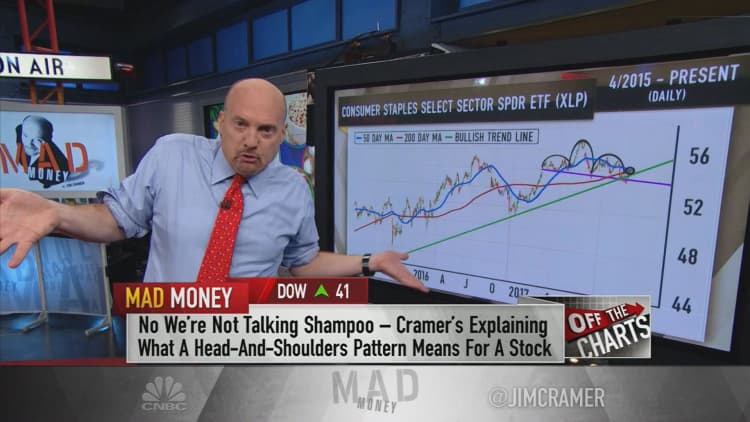
With the indexes breaking records, including the Dow Jones industrial average's all-time high on Tuesday, CNBC's Jim Cramer wanted to pause and investigate what's not working in this market.
"Even if the greatest bull run in ages is going on, there are losers and there are laggards, and they help define the action as much as the winners do," the "Mad Money" host said. "That's why we need to address the left-behind sector that is the consumer staples cohort, an important group that really hasn't participated in the last leg of this rally."
So Cramer called in technician Ed Posni, managing director of Barchetta Capital Management and Cramer's colleague at RealMoney.com, to help him unpack the charts for a better view of the consumer goods group.
Posni began with the Consumer Staples Select Sector SPDR Fund, an exchange-traded fund that follows most major consumer goods companies including Procter & Gamble, Coca-Cola, Philip Morris International, PepsiCo, Altria, CVS, Wal-Mart, Costco, Walgreens and Colgate-Palmolive.
While its performance hasn't been totally dismal, the consumer staples ETF, also known as the XLP, has traded flatly since February while the rest of the stock market has rallied to new highs.
And according to Posni, some of the XLP's technical indicators in its daily chart signal more negativity ahead. The technician pointed to its recent head-and-shoulders formation, one of the most bearish stock patterns in existence. The stock just broke below the "neckline," which is often a sign that a drastic pullback could be in the works.
What's worse, Posni noted that the XLP is already trading below its 50-day moving average and its 200-day moving average, both key tools for measuring where a stock is headed. Moreover, its 50-day moving average is about to cross below its 200-day moving average, which means the XLP's short-term outlook is weaker than its long-term outlook.
"That's an extremely negative sign, so negative that technicians like to call it the death cross," Cramer said. "It's very difficult to fight a bad chart and it's doubly difficult to fight a death cross. In short, based on what Ponsi's seeing here, the consumer staples ETF is in trouble."
To get to the heart of the issue, Cramer looked at some specific stocks dragging the ETF down, like Kraft Heinz. Given the competition in the supermarket space and Amazon's encroachment, grocery stocks have been pummeled of late.
In particular, "pantry plays" like Kraft Heinz have been sold off because consumers increasingly want organic, fresh food, not packaged, artificial goods like Kraft Heinz's Velveeta, Cramer said.
Looking at Kraft Heinz's daily chart, Posni said the stock has been making lower highs and lower lows, an indication that it's experiencing a downtrend. Its moving averages also made a "death cross" in August, and since then, shares have fallen from $86 to $77, breaking below their former floor of support at $80.
"Broken support is another one of these things technicians don't want to see. [It] often signals a further nasty decline," Cramer said. "In short, Ponsi says it's an ugly chart."
General Mills' daily chart does not provide a much better outlook. Posni found the stock stuck in a bearish channel, trapped below its 200-day moving average for a whole year.
Worse yet, General Mills shares recently passed under their $53 support level. At $51, the stock's downward-facing trading range is signaling more pain ahead, Cramer said.
But as ugly as the consumer staples' charts are, the "Mad Money" host maintained that the market's losers are just as important as its leaders.
"If you want a healthy bull market, the consumer staples stocks are exactly the ones we need to leave behind. These are classic, recession-proof names that investors buy when they're worried about a slowing economy. The fact that they're being sold indicates Wall Street is more confident about the future," Cramer said. "Bottom line: the charts, as interpreted by Ed Ponsi, suggest that the consumer staples cohort and, in particular, the food stocks could have more downside. That's an absolutely essential component if the bull herd can continue to thunder."
WATCH: Cramer's dismal charts shed light on market confidence

Disclosure: Cramer's charitable trust owns shares of PepsiCo.
Questions for Cramer?
Call Cramer: 1-800-743-CNBC
Want to take a deep dive into Cramer's world? Hit him up!
Mad Money Twitter - Jim Cramer Twitter - Facebook - Instagram - Vine
Questions, comments, suggestions for the "Mad Money" website? madcap@cnbc.com



